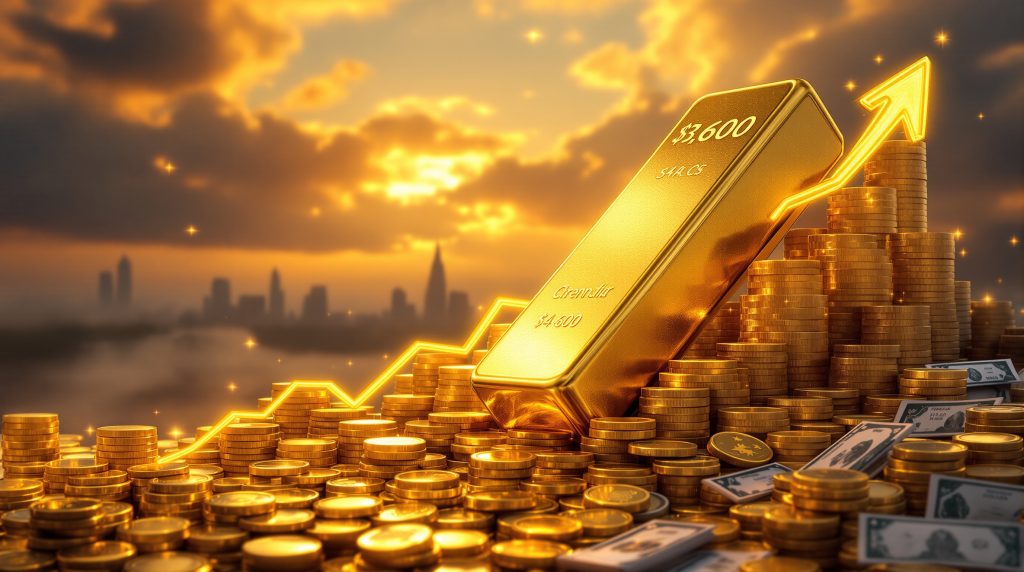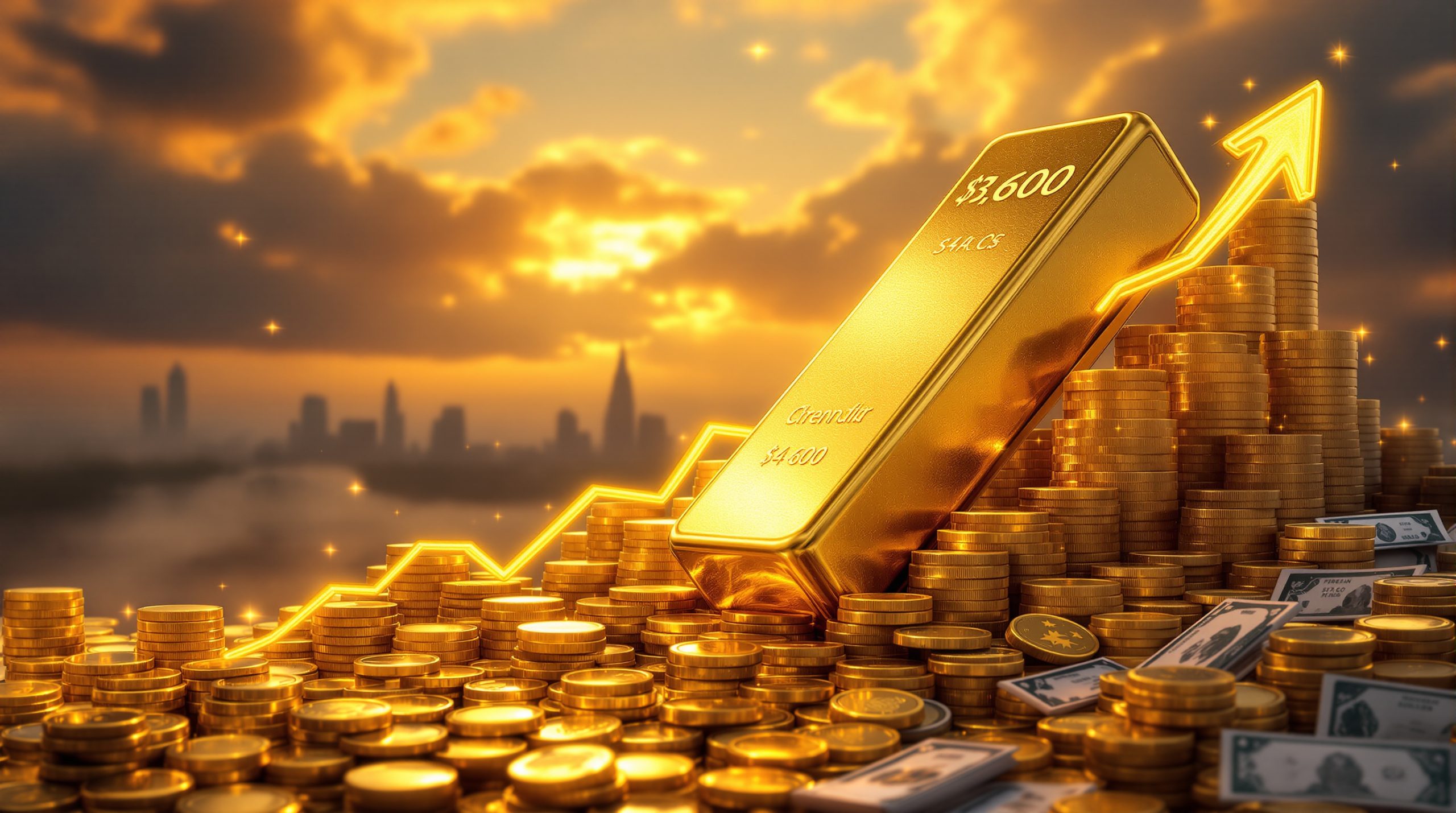Understanding the Gold Price Surge: Causes, Impacts, and Future Outlook
Gold has reached unprecedented levels above $3,500 per ounce in 2025, signaling a fundamental shift in how investors and central banks view traditional safe-haven assets. This remarkable transformation in the gold market represents more than a typical fluctuation—it reflects growing economic uncertainty and a convergence of factors creating perfect conditions for gold's dramatic ascent, challenging previous assumptions about price ceilings.
Key Drivers Behind Gold's Meteoric Rise
Recent economic data reveals concerning trends supporting gold's upward momentum. The Bureau of Labor Statistics reported a headline gain of just 22,000 jobs, but deeper analysis paints a more troubling picture. Without statistical adjustments, the core number would have shown a decline of 74,000 jobs—pointing to economic contraction rather than growth.
This economic uncertainty has triggered several notable market responses:
- The bond market has demonstrated a clear flight to safety, with 10-year Treasury yields falling sharply
- Gold spot prices have touched $3,600 per ounce, reflecting unprecedented demand
- Silver futures have reached 14-year highs exceeding $42 per ounce
- Traditional equity markets are struggling to maintain momentum
How Are Central Banks Influencing the Gold Market?
The Federal Reserve's influence on financial markets appears to be diminishing compared to previous decades. Market analysts increasingly question whether the Fed maintains the same level of market control it once commanded. The futures market currently prices in three quarter-point rate cuts by year-end, reflecting expectations that the Fed will attempt to stimulate a slowing economy.
A critical question emerges: Can the Fed effectively boost the economy if global bond markets are simultaneously revolting against fiscal indiscipline? This creates a paradoxical situation where short-term rate cuts might not translate to the intended effects on long-term rates that influence mortgages, auto loans, and other consumer borrowing.
Global Central Bank Gold Accumulation
Central banks worldwide, particularly those associated with BRICS nations, have been accumulating gold at historically significant rates. This strategic diversification away from traditional reserve currencies represents a structural shift in global monetary preferences.
Recent examples highlight this growing trend:
- El Salvador made its first gold purchase since 1990, adding $50 million to its reserves
- Asian central banks continue to lead global gold purchasing activity
- Western central banks have slowed or halted gold sales programs that were common in previous decades
What Does Gold's Price Action Tell Us About Economic Health?
Gold as an Economic Barometer
Gold's price movement serves as a powerful indicator of underlying economic conditions—often more honest than official statistics or equity market performance. The metal's sustained strength signals deep concerns about:
- The reliability of economic data and potential statistical manipulations
- Structural weaknesses in labor markets despite headline unemployment figures
- Mounting government debt levels across major economies
- Declining confidence in traditional monetary policies
The current gold price surge suggests markets are pricing in significant economic challenges ahead, regardless of more optimistic narratives from other quarters.
Divergence Between Financial Assets and Hard Assets
A notable divergence has emerged between traditional financial assets and hard assets like gold and silver. While equity markets showed resilience until recently, precious metals have been steadily appreciating—suggesting smart money is increasingly seeking tangible stores of value amid growing economic uncertainty.
This divergence becomes particularly meaningful when examining consumer behavior globally:
- In Asian markets, particularly China, consumers are increasingly converting cash savings into physical gold
- In Western markets, consumer spending remains heavily dependent on credit expansion
- Institutional investors and corporate insiders have recently increased selling of equities while gold demand strengthens
How High Could Gold Prices Go?
Price Projections and Historical Context
Current gold price forecast models vary widely, but several analysts have established meaningful targets based on fundamental and technical factors:
| Time Frame | Conservative Estimate | Moderate Estimate | Aggressive Estimate |
|---|---|---|---|
| End of 2025 | $3,500 | $3,700 | $4,000+ |
| Mid-2026 | $3,700 | $4,000 | $5,000 |
| Long-term (2030) | $4,000 | $5,000+ | $10,000+ |
These projections must be considered in historical context. Previous price barriers that seemed insurmountable were eventually broken as fundamental conditions shifted. When gold first broke through $2,000, predictions of $5,000 or $10,000 seemed outlandish—yet the current trajectory makes these targets increasingly plausible.
Inflation-Adjusted Historical Highs
When adjusting for inflation, gold's previous price peaks would translate to significantly higher levels in today's dollars:
- The 1980 peak of $850 would equal approximately $3,200 in today's purchasing power
- The 2011 peak of $1,900 would translate to roughly $2,600 today
This suggests that even at current levels, gold may not be overvalued from a historical perspective when accounting for currency debasement over time.
What About Silver's Parallel Surge?
Silver's Outperformance and Industrial Demand
While gold captures headlines, silver has experienced an even more dramatic percentage increase, reaching 14-year highs above $42 per ounce. This represents a powerful confirmation of the precious metals bull market, as silver typically amplifies gold's movements in strong trend environments.
Silver's case is particularly compelling due to its dual role:
- As a monetary metal with safe-haven characteristics similar to gold
- As an industrial metal with growing applications in renewable energy, electronics, and medical fields
This combination of monetary and industrial demand creates a uniquely bullish case for silver, with some analysts projecting potential prices of $100 per ounce in coming years—a level that would still be below the inflation-adjusted 1980 high of nearly $200 in today's dollars.
How Are Mining Companies Positioned in This Bull Market?
Mining Company Financial Strength
Major mining companies are entering this bull market in their strongest financial position in decades. Unlike previous cycles where producers quickly leveraged their balance sheets to pursue acquisitions at peak prices, today's majors have:
- Record free cash flow generation
- Substantially reduced debt levels
- Disciplined capital allocation strategies
- Improved operational efficiencies
This financial strength provides significant optionality for strategic growth without the financial risks that plagued the sector in previous cycles.
The Junior Mining Opportunity
While major producers have already seen substantial share price appreciation, junior mining companies focused on exploration and development represent a potential opportunity for investors willing to accept higher risk. These companies offer leveraged exposure to rising metal prices, though with significantly higher volatility.
Key characteristics to evaluate in junior mining investments include:
- Management teams with significant personal investment ("skin in the game")
- Projects in politically stable jurisdictions with clear permitting pathways
- Deposits containing in-demand metals like gold, silver, and copper
- Clear path to production or acquisition by larger companies
What Broader Economic Signals Does the Gold Surge Send?
Currency Confidence and De-Dollarization
Gold's surge reflects growing concerns about the long-term stability of traditional reserve currencies, particularly the US dollar. Several factors contribute to this narrative:
- Unprecedented government debt levels across major economies
- Expansion of central bank balance sheets through quantitative easing programs
- Growing international efforts to reduce dollar dependence in trade and reserves
- The emergence of alternative payment systems and financial alliances
These trends suggest a potential shift in the dollar's global reserve currency status—a transition that would fundamentally reshape the international monetary system and likely support significantly higher gold prices.
Political Risk Premium
Markets appear to be pricing in a growing political risk premium as monetary and fiscal institutions face increasing political pressure. This includes concerns about:
- Political influence over central bank policy decisions
- Manipulation of economic statistics for political purposes
- Growing populist pressures for monetary solutions to fiscal problems
- Potential for more extreme policy responses to economic challenges
These political factors add another dimension to gold as inflation hedge beyond traditional safe-haven characteristics.
What Are the Implications for Investors?
Portfolio Allocation Strategies
The current gold market dynamics suggest several potential gold investment strategies:
- Core Position: Maintaining a strategic allocation to physical gold and silver as insurance against monetary instability
- Mining Equity Exposure: Adding quality mining companies with strong balance sheets and growing production profiles
- Junior Speculation: For risk-tolerant investors, selectively adding junior mining exposure for potential outsized returns
- Systematic Rebalancing: Implementing a disciplined approach to taking profits and reallocating during periods of extreme volatility
The key insight is that precious metals exposure should be viewed as a strategic portfolio component rather than a short-term tactical trade.
Signs of Market Excess to Monitor
While the fundamental case for gold remains strong, investors should remain alert to potential signs of market excess that could signal temporary tops:
- Mainstream financial media suddenly becoming universally bullish on gold
- Casual acquaintances offering gold investment advice
- Extreme short-term price movements (>5% daily moves)
- Explosion of new gold-related investment products and services
- Mining company valuations detaching completely from underlying fundamentals
Conclusion: A New Paradigm for Precious Metals?
The current all-time high analysis appears to be more than just another cyclical move—it potentially signals a fundamental reassessment of gold's role in the global financial system. Unlike previous bull markets driven primarily by inflation concerns or specific geopolitical events, today's move reflects deeper structural shifts:
- Eroding confidence in traditional monetary authorities
- Growing recognition of unsustainable global debt dynamics
- Accelerating diversification away from traditional reserve currencies
- Increasing demand from both institutional and retail investors globally
These factors suggest the possibility that gold is entering a new long-term bull market that could see prices significantly higher than current levels over the coming years. While volatility will remain a constant feature of the market, the fundamental drivers appear firmly established for continued strength in precious metals prices.
Disclaimer: The price projections and market analysis presented in this article represent opinions based on current market conditions and historical patterns. Precious metals markets are inherently volatile, and actual price movements may differ significantly from the scenarios outlined. Investors should conduct their own research and consider their individual financial circumstances before making investment decisions.
Ready to Stay Ahead of Gold's Next Price Movement?
Don't miss crucial market insights powered by Discovery Alert's proprietary Discovery IQ model – receive real-time alerts on significant ASX gold discoveries that could drive substantial returns in this bullish market. Visit the dedicated discoveries page to see how major mineral finds have historically delivered exceptional investor outcomes.




